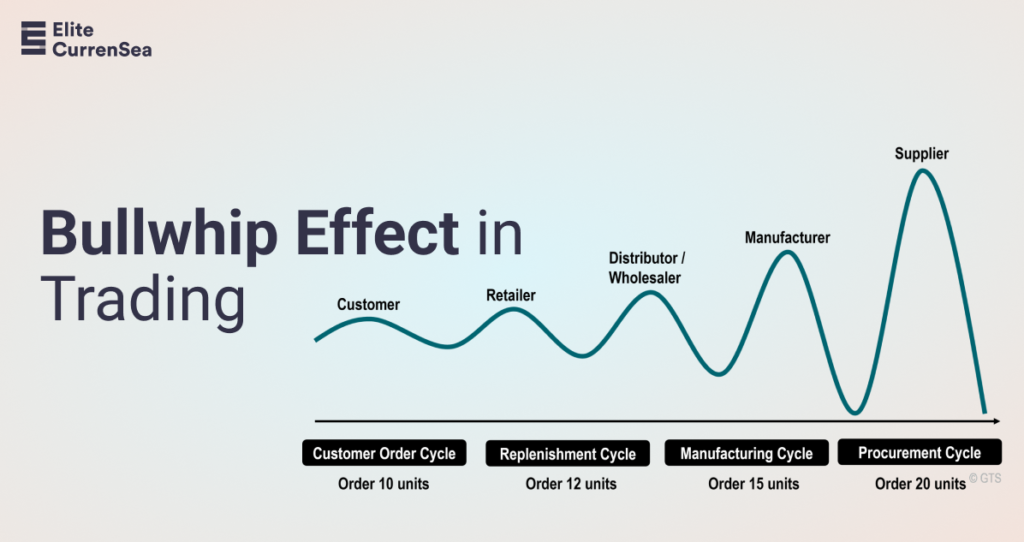The Bullwhip Effect in Trading: A Double-Edged Sword for Market Analysis

The financial market landscape is ever-changing, and analysts are always on the lookout for new strategies and methods to predict market movements. One such phenomenon that has piqued the interest of traders and investors alike is the “Bullwhip Effect”, which we have alluded in our previous take on what to expect from the market in the second half of 2023.
While this term has its origins in supply chain management, it has found a place in the world of trading as well. In this blog post, we will delve into the pros and cons of the Bullwhip Effect in trading, its most popular use cases, and examples, as well as provide some constructive criticism.
Understanding the Bullwhip Effect
The Bullwhip Effect refers to the amplification and distortion of demand fluctuations along the supply chain. In the context of trading, it describes the ripple effect of market volatility, where small changes in market conditions can lead to increasingly significant swings in stock prices and trading volumes.
This phenomenon can be useful for traders and investors looking to capitalize on the resulting price movements. Michael Burry (mr Big Short) alluded to this not so long ago (he of course then deleted the tweet😃).
Pros of the Bullwhip Effect in Trading
- Identification of opportunities: Traders can use the Bullwhip Effect to identify potentially profitable trading opportunities as market fluctuations can create short-term imbalances in supply and demand. By staying ahead of these trends, traders can gain a competitive advantage and maximize their returns.
- Enhanced risk management: Recognizing the presence of the Bullwhip Effect can help traders and investors manage risk more effectively. By understanding the potential for amplified price movements, they can adjust their positions accordingly to protect their investments.
- Improved market understanding: Studying the Bullwhip Effect can help traders gain a deeper understanding of market dynamics and the various factors influencing price movements. This knowledge can be invaluable when making informed trading decisions.
Cons of the Bullwhip Effect in Trading
- Difficulty in prediction: The Bullwhip Effect can be challenging to predict accurately due to the complex interplay of factors that contribute to market volatility. This can make it difficult for traders to determine the optimal time to enter or exit a trade.
- Increased risk of losses: The amplified price movements associated with the Bullwhip Effect can lead to substantial losses if a trader’s predictions are incorrect. This highlights the importance of having a robust risk management strategy in place.
- Psychological impact: The Bullwhip Effect can create a sense of urgency among traders, leading to impulsive trading decisions. This can result in traders taking on excessive risk or deviating from their established trading plans.
Examples of Bullwhip Effect in Trading
- Short-term trading strategies: Day traders and swing traders can benefit from the Bullwhip Effect by capitalizing on the short-term price movements it creates. By identifying stocks with high volatility and potential for significant price swings, these traders can maximize their profits.
- Algorithmic trading: Some algorithmic trading strategies are designed to exploit the Bullwhip Effect by monitoring market volatility and adjusting their trades accordingly. These algorithms can help traders capture gains while minimizing their exposure to risk.
Real-World Examples of the Bullwhip Effect in Recent History
COVID-19 Pandemic: The outbreak of the COVID-19 pandemic in early 2020 led to significant market volatility and a prime example of the Bullwhip Effect. As global supply chains were disrupted and the demand for certain goods and services fluctuated wildly, stock prices experienced dramatic swings. This presented opportunities for traders who could capitalize on these price movements while also highlighting the risks associated with such volatile market conditions.
US-China Trade War: The ongoing trade tensions between the United States and China have also given rise to instances of the Bullwhip Effect. Tariffs, import/export restrictions, and fluctuating currency values have contributed to uncertainty and volatility in the financial markets. Traders who were able to anticipate the impact of these geopolitical events could benefit from the price swings, while others might have experienced losses due to the unpredictable nature of these developments.
Criticism & Limitations
While the Bullwhip Effect can provide valuable insights and opportunities for traders, it is crucial to acknowledge its limitations. Traders must use this phenomenon in conjunction with other technical and fundamental analysis tools to ensure a comprehensive understanding of the market. Additionally, maintaining strict risk management protocols is essential to protect against potential losses arising from the unpredictable nature of the Bullwhip Effect.
Extended Criticism: Limitations of Relying on the Bullwhip Effect
- Overemphasis on short-term trends: Focusing too heavily on the Bullwhip Effect may cause traders to overlook longer-term market trends and the underlying fundamentals of a particular asset. This can lead to short-sighted trading decisions that fail to account for the bigger picture.
- Inability to account for external factors: The Bullwhip Effect may not accurately capture the impact of certain external factors, such as regulatory changes or geopolitical events. Relying solely on this phenomenon could result in a trader being caught off-guard by unexpected developments that significantly impact the financial markets.
- Susceptibility to market manipulation: In some cases, the Bullwhip Effect can be exacerbated by market manipulation, such as pump-and-dump schemes or coordinated trading activity. Traders who rely on the Bullwhip Effect as a primary indicator may be vulnerable to falling prey to these manipulative tactics.
- No guarantee of future performance: The Bullwhip Effect, like any other market analysis tool, cannot guarantee success or predict future price movements with certainty. It is essential to remember that past performance does not guarantee future results and that all trading strategies carry inherent risks.
- Limited applicability for long-term investors: The Bullwhip Effect is primarily focused on short-term price movements and may not be suitable for long-term investors. Those with a long-term investment horizon should consider other factors, such as a company’s financial health, industry trends, and macroeconomic indicators, when making their investment decisions.
Wrapping in Up
In conclusion, while the Bullwhip Effect can provide valuable insights and potential trading opportunities, it is crucial to recognize its limitations and avoid relying on it exclusively.
A comprehensive approach to market analysis, incorporating both technical and fundamental factors, is essential for making informed trading decisions and mitigating risks associated with market volatility.
Safe Trading
Team of Elite CurrenSea










Leave a Reply